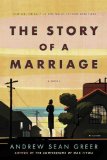Summary | Excerpt | Reading Guide | Reviews | Beyond the Book | Read-Alikes | Genres & Themes | Author Bio

Critics' Opinion:
Readers' Opinion:
First Published:
Apr 2008, 208 pages
Paperback:
Mar 2009, 208 pages
 Book Reviewed by:
Book Reviewed by:
Lucia Silva
Buy This Book
This article relates to The Story of a Marriage
"This is a war story. It was not meant to be. It started as a love story, the story of a marriage, but the war has stuck to everywhere like shattered glass. Not an ordinary story of men in battle, but of those who did not go to war. The cowards and shirkers; those who let an error keep them from their duty, those who saw it and hid, those who stood up and refused it, even those too young to know that one day they would rise and flee their own country... The story of those men, and of a woman in a window, unable to do a thing but watch."
- The Story of a Marriage.
It would spoil the story to reveal too much about the plot of The Story of a Marriage, but the war and not going to war figure prominently throughout, in different incarnations and different wars, including a conscientious objector in WWII.
We mostly associate conscientious objectors with the Vietnam War, not so much with "The Good War". But even as America united nearly wholly with the good vs. evil characterization of WWII, there were still men whose religious and ethical beliefs prevented them from killing other human beings. Most objectors belonged to traditionally pacifist religions like the Quakers, Mennonites and Jehovah's Witnesses, but there were also Jews, Muslims, Catholics, and others, including some who objected for political and ethical reasons.
70,000 men applied for conscientious objector status during WWII, but The Selective Service Act of 1940 only allowed men to legally defer for religious reasons. A little over half of the men who applied for CO status received it. Known as conchies, they were given a choice of noncombatant service in the Armed Forces, as unarmed medics or chaplains, or they could enlist in alternative service, as road-builders, fire-fighters, attendants in mental institutions, subjects in medical experiments, or working in Civilian Public Service (CPS) camps. The CPS camps were formed in an unusual collaboration between the traditional peace churches (Quakers, Bretheren, Mennonites) and the US government, providing the first legal alternative service to combat for COs. Many men worked in the camps for the duration of the war, working 9-hour days, six days a week, of hard labor, for which they were not paid. In fact, they were expected to pay the government for their room and board, but church communities paid the fees for most of their COs who could not afford to. Many families of COs were left in dire poverty, shunned by their communities and extended families.
While the government viewed the camps as a way to keep the COs out of sight, the peace churches initially envisioned them as utopian pacifist communities. When much of the labor turned into pointless busywork, some COs chose to leave the camps in protest and join the 6000 COs who were imprisoned in jails. During WWII one of every six men in US prisons was a draft resister who had not received legal CO status or who refused to engage as noncombatants in the armed forces or work in the CPS camps. Still, many remained in the camps, and fostered emerging ideas about nonviolent protest, some becoming leaders in the civil rights and social justice movements in the decades to come.
"We had Ph.Ds, we had winners of Fulbright prizes, we had guys who had a third-grade education, we had stockbrokers, we had ballet dancers, we had atheists, we had fundamentalists...every possible kind of human being was there....And that made it a fascinating place to be." - Steve Cary, WWII CO
Interesting Link: APBS sub-site about conscientious objectors during WWII, including a brief history of conscientious objection in the USA, which traces all the way back to the Founding Fathers themselves, such as Quaker pacifist William Penn.
Filed under People, Eras & Events
![]() This "beyond the book article" relates to The Story of a Marriage. It originally ran in June 2008 and has been updated for the
March 2009 paperback edition.
Go to magazine.
This "beyond the book article" relates to The Story of a Marriage. It originally ran in June 2008 and has been updated for the
March 2009 paperback edition.
Go to magazine.





The House on Biscayne Bay
by Chanel Cleeton
As death stalks a gothic mansion in Miami, the lives of two women intertwine as the past and present collide.

The Flower Sisters
by Michelle Collins Anderson
From the new Fannie Flagg of the Ozarks, a richly-woven story of family, forgiveness, and reinvention.

The Funeral Cryer by Wenyan Lu
Debut novelist Wenyan Lu brings us this witty yet profound story about one woman's midlife reawakening in contemporary rural China.
Your guide toexceptional books
BookBrowse seeks out and recommends the best in contemporary fiction and nonfiction—books that not only engage and entertain but also deepen our understanding of ourselves and the world around us.